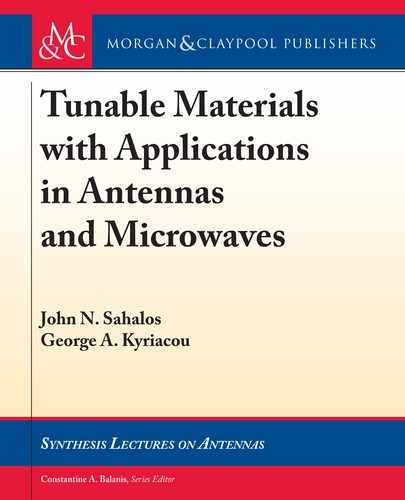
3.24. MAGNETOSTATIC WAVES ON MULTILAYER AND GROUNDED STRUCTURES 157
Note that the term e
jk
z
w=2
D e
j n=2
is constant and is thus absorbed in the constant
A
0
z
. e wavenumbers are still given by (3.234), which in view of (3.248) and adopting the
notation of [49] for direct comparison purposes, becomes:
N
2
D k
2
xd
D ˛
2
D k
2
y
C k
2
z
D k
2
y
C .n=w/
2
(3.250a)
M
2
D k
2
xi
D a
2
i
D k
2
y
C
k
2
z
.
1 C X
/
D k
2
y
C
.
n=w
/
2
.
1 C X
/
: (3.250b)
Remember that we are dealing with surface modes occurring when .1 C X / > 0. eir
dispersion equation (3.242) through (3.250) reads:
e
2Md
D
.1 C X /M k
1
k
y
C N
.1 C X /M C k
1
k
y
N
.1 C X /M C k
1
k
y
N tan.N t /
.1 C X /M k
1
k
y
C N tan.N t /
: (3.251)
In [49], the notation .1 C X / D
1
, k
1
D
2
and k
y
D k is used, while therein the struc-
ture is modeled upside down accessing infinity at x D 1. e latter justifies the different signs
observed in (3.251). Also [49], a question that is raised is about the slab-width effects. When
are they significant and when could they be ignored? A qualitative answer could say that width
effects are significant when the wavelength
y
D 2=k
y
is comparable or greater to the sam-
ple width (
y
D 2=k
y
w). On the contrary, in the limit when
y
<< w, a behavior like the
infinite film (3.242) is expected. A corresponding practical limit is set in [49]. Hence, the lim-
iting wavenumber is set to be k
w
D 10 n/w. When k
y
> k
w
or
y
< 0:628 w/n, width effects
are ignored and vice versa. Further, according to [49], volume modes may occur in the range of
.1 C X / < 0.
3.24.12 VOLUME MODES OF A SLAB FINITE IN THE z–DIMENSION
As explained in the previous section, volume modes tend to propagate along the direction of dc-
magnetization (Oz-axis) with jk
y
j ! 0 and jk
i
j k
z
. However, for the finite slab truncated in the
z-direction, there could be a small frequency range within .1 CX / < 0 where volume modes
occur. Remember that .1 CX / < 0 allows for all three wavenumbers k
xi
, k
y
, and k
z
to be real
(in the lossless case). In turn, expressions (3.248) through (3.250a) are valid, while (3.250b) is
modified as:
k
2
xi
D M
2
D
.n=w/
2
.1 C X /
k
2
y
> 0: (3.252)
e dispersion equation is given by (3.222), which is specialized for the present case by
substituting for k
xi
and k
xd
D ˛ from (3.252) and (3.250a), respectively.
Another point of interest stated in [49] is the possibility of surface waves (MSSW) to
become backward, i.e., to have opposite phase and group velocities.

158 3. FINITE FERRITE SAMPLES
3.24.13 VOLUME MODES OF A SLAB FINITE IN
y
–DIMENSION
A logical question could be raised as to why not study volume modes propagating in the z-
direction as e
jk
z
z
of slab finite in its y-dimension, and thus with a standing-wave pattern along
the y-axis. is is actually a very interesting case which is already exploited in practice, but for the
electromagnetic modes, also known as “edge modes.” ese modes have mode patterns cling to
either y D w=2 or y D Cw=2 and propagating in opposite z-directions. So, they are expected
to behave like the magnetostatic surface modes which cling to either top x D d=2 or bottom
x D d=2 face of the ungrounded slab. Learning from the latter situation, one intuitively expects
that a non-zero magnetic potential beyond y D ˙w=2 should be considered. However, this
becomes far too complicated to be analyzed herein. In order to realize the complication, let us
try to apply the “pinning” conditions of the previous section. at is, assume sample edges at
y D ˙w=2 and try to enforce the tangential flux density components b
x
and b
z
to be zero on
them. Consider a standing-wave eigenfunctions along y-axis as:
g.y/ D A
y
e
jk
y
y
C B
y
e
Cjk
y
y
: (3.253a)
Pinning b
z
at y D ˙w requires:
b
z
D
0
h
z
D
0
@ =@z D
0
.
jk
z
/
j
yD˙w=2
D 0:
en
g.y D ˙w=2/ D 0 ! k
y
w D mI m D 0; 1; 2; : : : (3.253b)
and g.y/ D A
0
y
sin
h
m
w
y
w
2
i
: (3.253c)
However, b
x
is also tangential and must be pinned at the edges. us:
b
x
D
0
.1 C X /
@
@x
C j k
1
@
@x
yD˙w=2
D 0: (3.254a)
is in turn asks for:
.1 C X /f
0
i
.x/g.y/ C jk
1
f
i
.x/g
0
.y/
yD˙w=2
D 0: (3.254b)
In view of (3.253c), the above requires:
g
0
.y D ˙w=2/ D
m
w
A
0
y
cos
h
m
w
y
w
2
i
yD˙w=2
D 0: (3.254c)
e above has only one solution, which is m D 0, or the potential to be zero everywhere.
Hence, the pinning conditions are unacceptable in this case.
Let us now study the magnetostatic forward volume of the finite grounded structure of
Figure 3.30.
..................Content has been hidden....................
You can't read the all page of ebook, please click here login for view all page.
